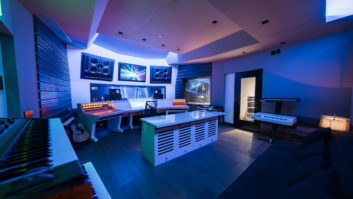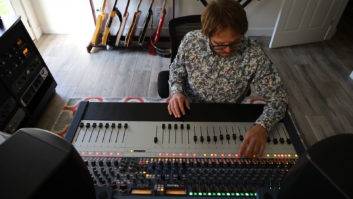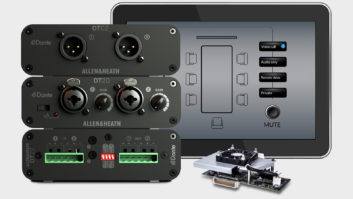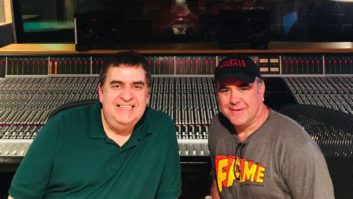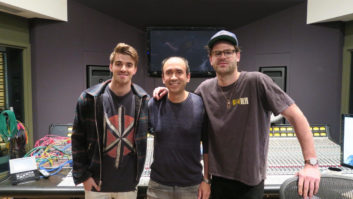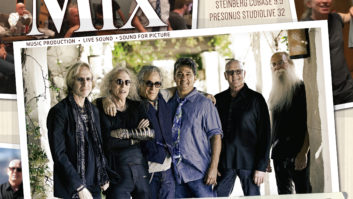Studio Consoles
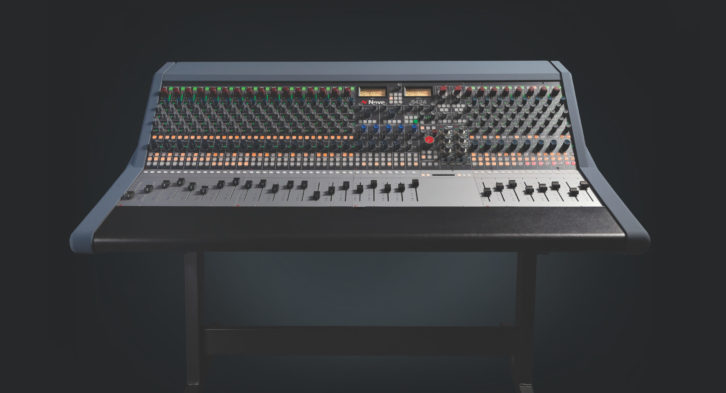
AMS Neve Neve 8424 Small-Format Console
AMS Neve has unveiled the Neve 8424 small format console with a large format sound based on the iconic 80-series console range. The 8424 console is designed to fit the needs of the modern hybrid studio. It provides a centralized platform with outstanding connectivity, facilitating an ergonomic link between the linear analog processing world of outboard gear, analog synths and instruments, to the digital world of DAW workflow, software plug-ins and session recall.
Recording: The 8424’s dual-input channel strip allows for seamless switching between recording and mixing inputs without additional patching. Simple input connectivity via 24 line-level inputs, dual 1073 preamps, and dual Instrument DI channels makes the 8424 the perfect console for artists to connect and record their instruments, and performers can record directly from the control room, taking advantage of the 8424’s dual cue mix system with talkback/return talkback capability and dual headphone amplifiers.
Mixing: The 8424 24 DAW returns across 24 channel faders or, for larger DAW sessions, a 48-Mix mode that allows a total of 48 mono inputs with individual level and pan controls to be mixed through the 8424’s Marinair transformer-coupled stereo mix bus. Engineers can take advantage of the 8424’s mono and stereo aux busses to connect to their favorite outboard FX units and route them back into the console’s two dedicated stereo reverb returns. Four mono groups with 2-band shelving EQ, Inserts, and Direct Outs make this console ideal for stem mixing.
Connecting: Each Channel, Group and Stereo Mix bus has its own switchable insert point, giving a level of connectivity to analog outboard units only found on large-format consoles. Dual on-board 500 series slots allow engineers to customize their signal chain and build a modular hybrid recording system, all connected and centralized through the 8424 console.
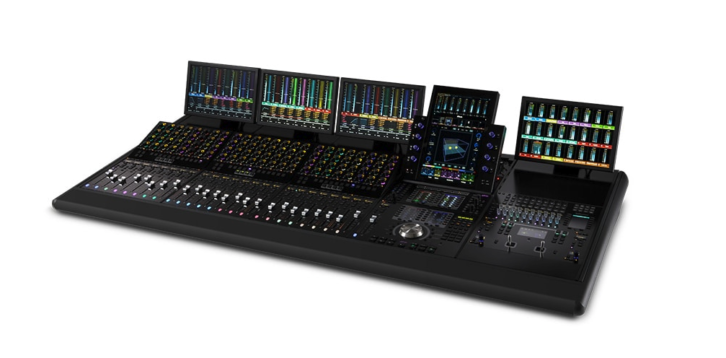
Avid S4, S1 Control Surfaces
Avid’s S1 and S4 EUCON control surfaces give users control of their favorite app’s as well as integrating with tablet devices. Features include motorized faders, touch-sensitive encoders, OLED display and modular scalability. The Avid S1 is the replacement for the older Artist Mix series, with new features, upgraded mechanics, and tablet integration.
Along with OLED displays, the S1 works with the Pro Tools | Control iPad app, allowing integration of the touchscreen functionality of the app with the hands-on control of the surface. Up to four units can be linked together, along with the Pro Tools Dock. Since the unit is EUCON enabled, it supports multi-application control and switching. Use the S1 to control favorite applications for audio and video, all over high-speed ethernet control. The S1 can also be controlled with Mackie/HUI applications. The S1 can run either iPad or Android devices.
Avid’s S4 is a smaller, more affordable solution to the larger S6, offering the same streamlined workflows, Pro Tools intelligent control and modular scalability to the budget-conscious production professional. Specifically aimed at smaller budget-minded production studios in music and post, the S4 allows for modular growth as client needs grow. Available in either a 3-foot eight-fader system, a 4-foot 16-fader system or a five-foot 16/24-fader base system, the units support the addition of Display Modules, Joystick Surround Modules, as well as the Post Module aimed at Post-Production facilities.
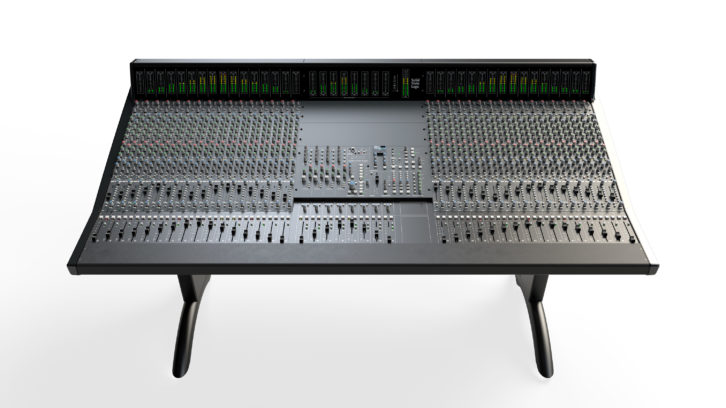
Solid State Logic’s Origin Analog Inline Console
Introduced at AES New York 2019, Solid State Logic’s Origin fully analog inline console 16 buses, E Series EQ and the classic Bus Compressor with features and functionality for today’s hybrid workflows.
The new PureDrive mic pre inherits the sound of previous SSL Mic Pre designs, that can also switch character to a warm, harmonically rich tone that varies with mic pre gain. Origin’s new mix bus and mix amp architecture reportedly delivers a low noise floor along with appropriate headroom for a summing bus, according to the manufacturer. Balanced insert points per channel path, dedicated channel direct outputs, stem-ready 0 dB fader bypass switches and a new configurable center section enable integration into a modern production studio.
The adjustable center section features 12U of rack space, allowing the modular 6U master tile to be repositioned to create space for software controllers, a computer keyboard or additional outboard processing. The meter bridge can also be lowered into the center section, enabling a screen to be positioned so all your production software can be viewed just where you need it.
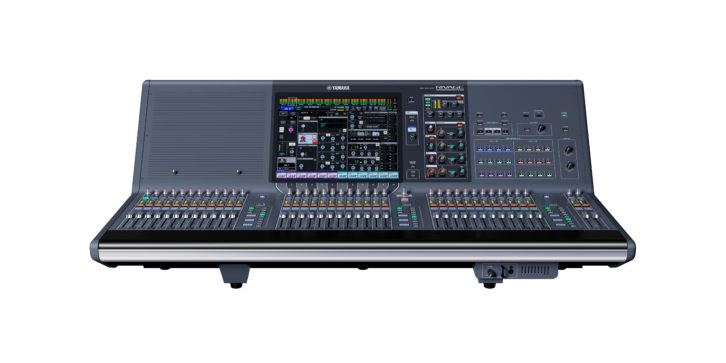
Yamaha Expands RIVAGE Systems
Yamaha Corporation is introducing new additions to the company’s professional audio lineup-the RIVAGE PM5 and RIVAGE PM3 Digital Mixing Systems. The systems feature new CS-R5 and CS-R3 control surfaces, along with the DSP-RX and DSP-RX-EX DSP engines.
The CS-R5 control surface for RIVAGE PM5 systems features three large touchscreens and a condensed selected channel section that contribute to smooth intuitive operation. The CS-R3 control surface for RIVAGE PM3 systems packs full RIVAGE PM series functionality and performance into a console that is only 45 inches wide, making it the most compact console in the series.
The new DSP-RX engine provides 120 inputs, 48 mix buses and 24 matrices, whereas the DSP-RX-EX engine has 288 inputs, 72 mix buses and 36 matrices. The availability of two DSP engines with different mixing capacities, along with the two new control surfaces, offers greatly expanded flexibility for creating systems that are ideally suited to applications of just about any scale.
The new hardware will be released simultaneously with firmware version 4.0.
Live Consoles

Allen & Heath Avantis 96 kHz Digital Mixing Console
Allen & Heath completed its trilogy of 96 kHz digital mixing consoles with the launch of Avantis, a brand-new desk based on the company’s XCVI FPGA engine. It places Allen & Heath’s next-generation technology in a 64-channel/42-configurable-bus unit, providing twin HD touchscreens, extensive I/O options and processing taken from the company’s flagship dLive mixing system.
The console is part of Allen & Heath’s Everything I/O ecosystem, whose name signifies the idea that all the parts connect seamlessly. Avantis can be connected to a range of audio expander hardware and is also compatible with Allen & Heath’s range of ME Personal Mixers and IP hardware remote controllers.
For local I/O, Avantis comes equipped with 12 XLR analog inputs and 12 XLR analog outputs, plus AES (stereo in, two stereo out). Two additional I/O ports ensure users can draw the full range of current dLive option cards, including Dante, Waves, gigaACE, MADI and more, expanding the scope for system integration, FOH/monitor splits and multitrack recording.
The console is loaded with an array of processing tools, including compressors, EQs and Allen & Heath RackExtra FX units (12 slots). Upgrading to dPack expands Avantis further with additional dLive processing, including the Dyn8 dynamics engine (up to 16 instances), DEEP compressors and the Dual-Stage Valve preamp.
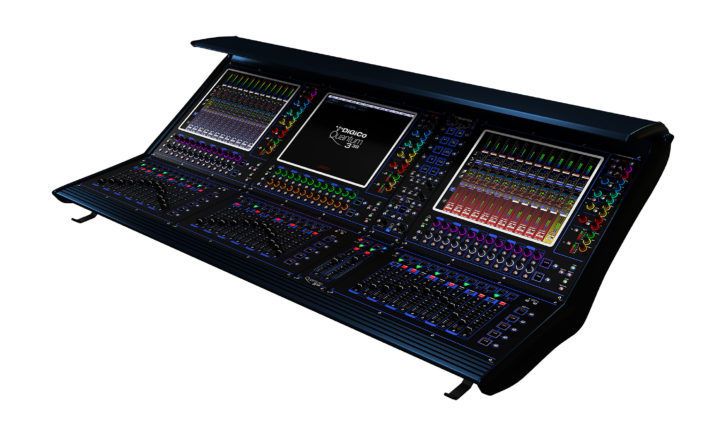
DiGiCo Spotlights Quantum 338 Mixing Console
DiGiCo’s new Quantum338 mixing console is based on seventh-generation FPGAs and includes 128 input channels with 64 busses and a 24 x 24 matrix, all with full channel processing. There is a new dark mode application and three 17-inch, 1000-nit high-brightness multi-touchscreens, allowing both the meter bridge and soft quick select buttons to be displayed on each screen. There are also 70 individual TFT channel displays, and the floating Quantum chassis features 38 x 100mm touch-sensitive faders laid out in three blocks of 12 fader banks, plus two dedicated user-assignable faders, each complete with high resolution metering.
A new level of local audio connectivity and performance comes via the “Ultimate Stadius” 32-bit ADC and DAC conversion, built into Quantum338 as standard, alongside six single or three redundant MADI connections, dual DMI slots and a built-in UB MADI USB recording interface. Mustard Processing, Spice Rack, Nodal Processing and True Solo are also standard on the Quantum338.
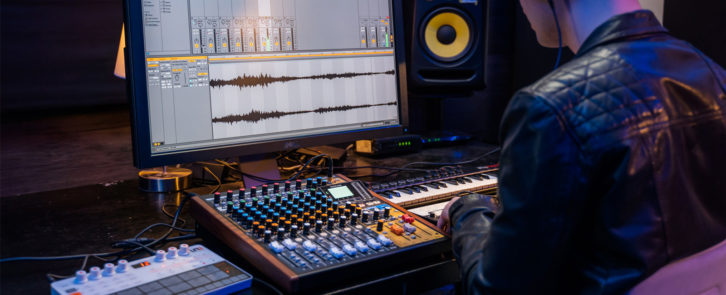
TASCAM Upgrades Model 12 With VAMP Feature
TASCAM is adding the new VAMP feature to its Model 12 Integrated Production Suite. Designed for a wide range of applications including rehearsals, individual practice and live performance, the new VAMP feature provides a repetitive playback loop between two selected points in a song, enabling interactive live playback for extended solos and jams, plus repeated playback of a selected individual track for rehearsal purposes.
Executing the new VAMP playback function—added by way of the V1.10 firmware update—can be accomplished via the Model 12’s LCD display or using the optional RC-1F footswitch. In the studio, the VAMP feature enables, for example, a soloist to rehearse his/her performance prior to actually recording it. Similarly, the VAMP feature is an ideal individual practice aid that helps musicians fine-tune their performances through difficult passages. In live applications, the VAMP feature gives the band the ability to extend various sections of a song. Examples include extending an instrumental solo or repeating the “hook” of a song indefinitely for the purpose of keeping the dance floor active.
The Model 12’s new VAMP feature offers up to 10 pairs of start/end points in a single song. The new VAMP feature delivers seamless playback across multiple tracks, ensuring intuitive operation both when setting loop points and when extending playback during performance. Equally notable, users can freely mute or change volume levels on every other track in a song using the Model 12’s faders while still having the VAMP function playing.
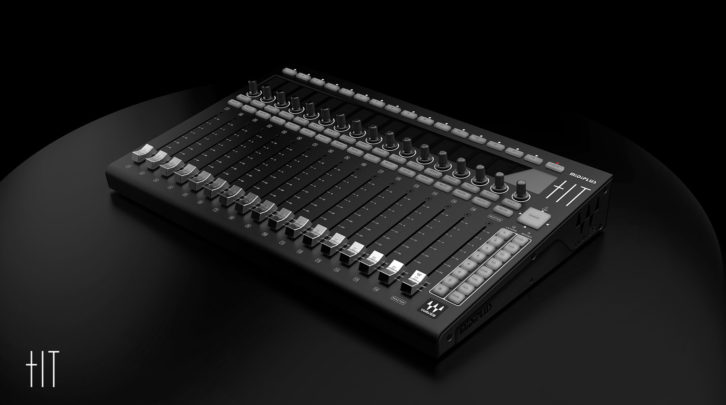
Waves FIT Controller for eMotion LV1 Live Mixer
Waves Audio’s new Waves FIT Controller for the eMotion LV1 Live Mixer is a tactile live sound controller created in collaboration with MidiPlus. FIT is designed to function as a 16-fader bank with the LV1 mixer, sporting 16 + 1 motorized 100mm faders, each featuring Mute, Solo and Select buttons, a multi-function rotary control and a display for each channel. Fader banks are controlled using eight dedicated layer switches for toggling between the eight factory or custom layers in the Waves eMotion LV1 Live Mixer.
The channel rotary controls can be set to adjust preamp gain or pan per channel with the corresponding function label shown in the display. In addition, the 16 Select channel toggles can be set to “User” mode to provide easy access to Mute Groups and user-assignable keys.
The channel rotary controls can be set to adjust preamp gain or pan per channel with the corresponding function label shown in the display. In addition, the 16 Select channel toggles can be set to “User” mode to provide access to Mute Groups and user-assignable keys.
The controller weighs 4.5 lbs. and can be fitted with rack ears to mount into a 19-inch 7U rack space. Rear panel connections include a USB Type B port for computer connection, 12V 2A DC power input and two 5v 0.5A USB outlets for external LED lighting.
